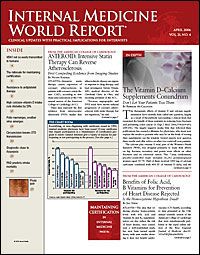Publication
Article
Internal Medicine World Report
Diet Rich in Whole Grains May Help Ward Off Diabetes
Adiet high in whole-grain foods that are rich in bran, fiber, vitamins, and minerals may lower a person's risks of developing type 2 diabetes and heart disease, new data suggest (Am J Clin Nutr. 2006;83:275-283).
This study was based on an analysis of the diet records and available blood samples from healthy, middle-aged men (n = 469) and women (n = 473) who were part of the Health Professionals' Follow-up Study (HPFS) and the Nurses' Health Study II (NHS II). The study was conducted by Majken K. Jensen, of the Harvard School of Public Health, Boston, and colleagues.
HPFS was initiated in 1986 and included 51,529 men who were 40 to 75 years old at baseline. They were given lifestyle and health questionnaires every 2 years and a food frequency questionnaire (FFQ) every 4 years. NHS II included 11,6671 women who were 25 to 42 years old when the study began in 1989. Their health status was monitored periodically.
In the current study, diet was assessed using a 131-item FFQ; intake of whole grains (including 2 key parts that make up whole grains: the bran and the germ) was measured; and levels of serum homocysteine and 10 other variables of lipid metabolism, glycemic control, and inflammatory changes were monitored. The primary end point was the relationship between diet and markers of glycemic control (eg, fasting insulin and hemoglobin A1c) that indicated diabetes risk, as well as their relation to lipid levels and to markers of inflammation (eg, homocysteine).
Median intake of whole grains was 22.3 g/day in the entire study population. Among the men, whole grain intake ranged from 0.4 to 124 g/day; in the women, it ranged from 3.1 to 77 g/day. Among both men and women, median bran intake was 5 g/day, and median germ intake was 0.93 g/day.
Those with higher levels of whole grain intake were more likely to be more physically active, to consume more fruits and vegetables, to not smoke, and to consume less alcohol and saturated and monounsaturated fats than those with lower whole grain intake.
As shown in the Table, those in the highest whole grain intake group had a better lipid profile and lower levels of both glycemic control markers and homocysteine than those in the lowest intake group. However, there appeared to be no association between whole grain intake and markers of inflammation.
"We found that higher intakes of whole grains in healthy men and women were associated with homocysteine concentrations and markers of improved glycemic control," the investigators wrote. "Furthermore, the associations between the whole grain components?bran and germ?and the biomarkers were not appreciably different."
A second study (Diabetes Care. 2006; 29:207-211) found that a low-glycemic diet rich in whole grains may also decrease systemic inflammation in women with diabetes.
This study included 902 women with diabetes from the NHS. Their diet was assessed in 1986 and in 1990 using semiquantitative FFQs.
After adjusting for body mass index and diet, consumption of whole grains and bran was associated with a trend toward reduced concentrations of C-reactive protein (CRP) and tumor necrosis factor-a receptor 2 (TNF-R2). Those with the lowest cereal fiber intake had a 32% increase in CRP level and an 11% increase in TNF-R2 concentration.?R.M.





